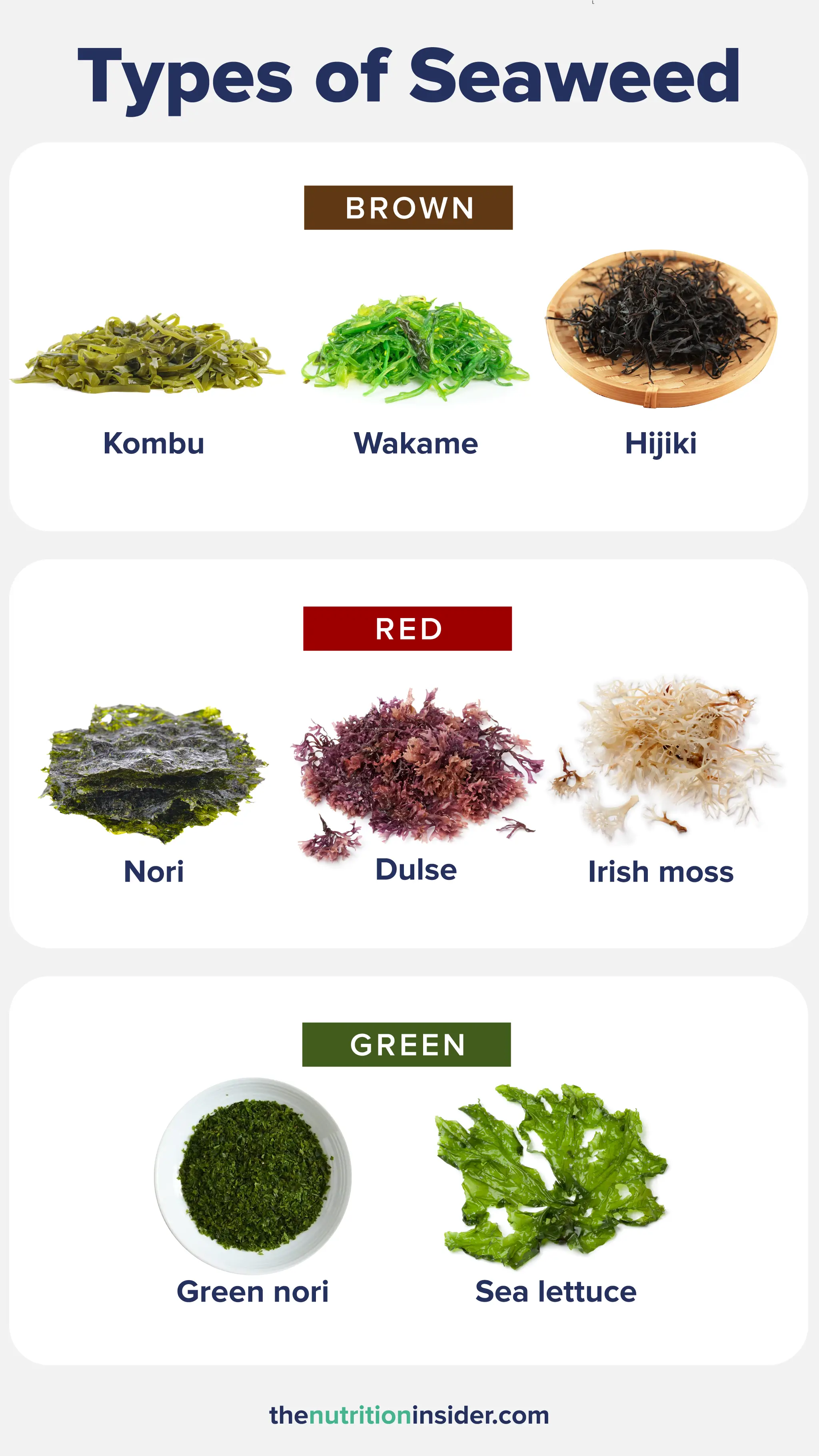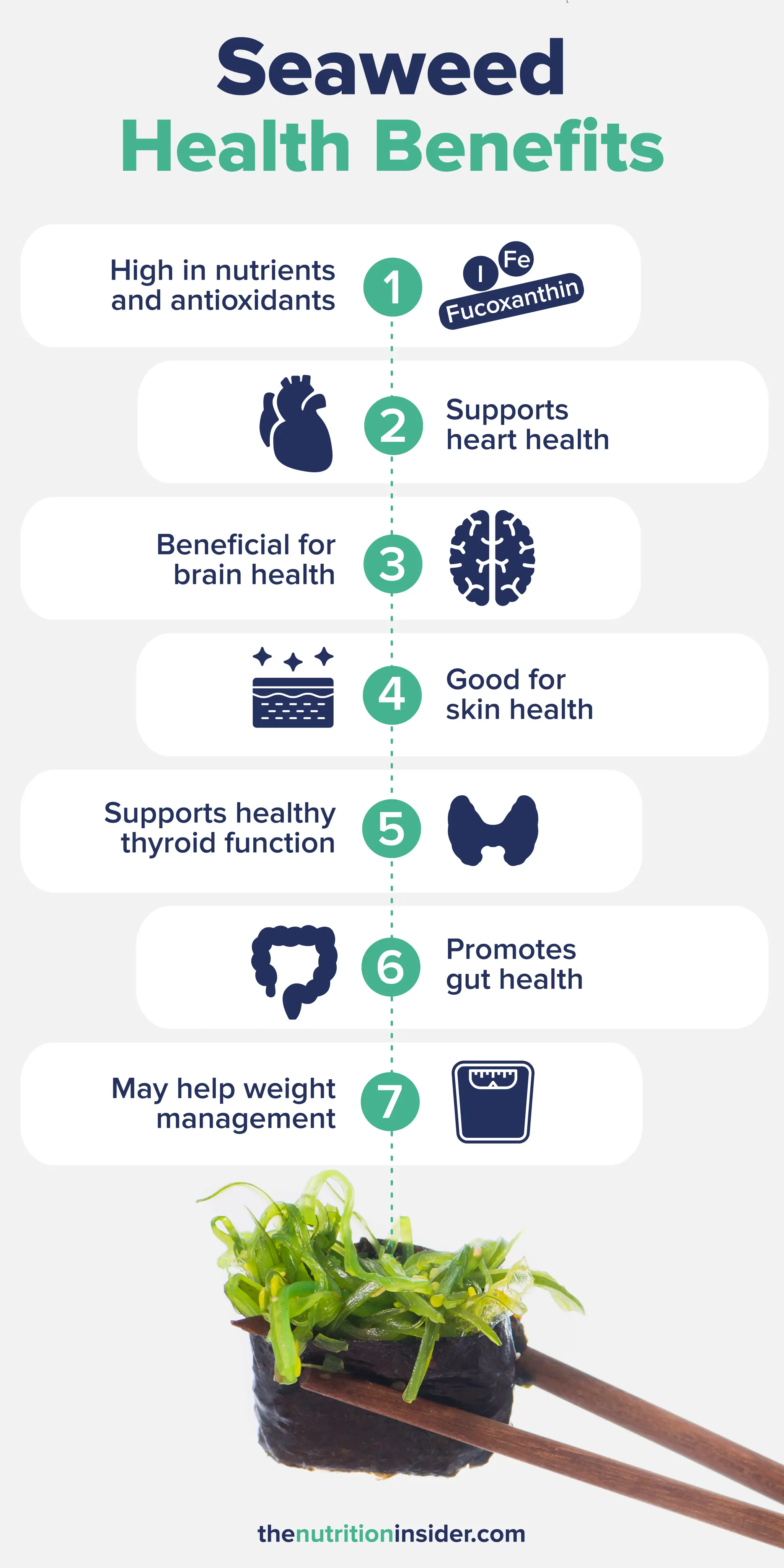Talk to a Registered Dietitian and use INSIDER20 for 20% off!
Talk to a real Dietitian for only $99: Schedule Now
This post contains links through which we may earn a small commission should you make a purchase from a brand. This in no way affects our ability to objectively critique the products and brands we review.
Evidence Based Research To fulfill our commitment to bringing our audience accurate and insightful content, our expert writers and medical reviewers rely on carefully curated research.
Read Our Editorial Policy
With evidence of its use as both food and medicine dating back to the Mesolithic period in countries like Japan, Korea, Chile, Ireland, and Iceland, seaweed has been a staple food for millennia, providing a vital source of essential micronutrients, fiber, and antioxidants.1,2
Despite the use of seaweed in cultures around the globe, the U.S. has been slow to adapt to consuming this nutritional powerhouse. Although coastal Indigenous tribes like the Makah of the Pacific Northwest certainly utilized seaweed, it did not become mainstream in the U.S. until the health-conscious eras of the 1980s and 90s.3
If your only introduction to seaweed has been the little strip wrapped around your spicy tuna roll, you’re not alone—but there is a whole world of seaweed to be explored. In this article, we’ll dive into all the different varieties and seaweed benefits for health.
There are a whopping 10,000 different species of seaweed living in our oceans, with 145 of these species being eaten today (mostly in Asia). However, an even smaller amount is commonly consumed around the world, with just a handful of species being the most popular.
Although people often use “seaweed” and “kelp” interchangeably, they are not the same. Seaweed is in the algae family, and kelp is the largest subtype of seaweed. Essentially, all kelp are a type of seaweed, but not all seaweed is kelp.

In general, edible seaweed can be grouped into three categories: brown, red, or green seaweed—here are a few of the most commonly consumed types of each:
Brown seaweed is olive green to brownish in color, often found in deep, cold waters and used in soups and broths. The most common types of brown seaweed include:
With pinkish to deep red hues, red seaweed is the kind most often used in sushi rolls (it is red when it grows but turns deep green during the drying and roasting process), with types including:
Green seaweed is less consumed, with its bright green varieties originating in shallow waters and often used in fresh seaweed salads. Just like green plants growing on land, green seaweed contains chlorophyll.
Now, let’s take a look at some of the leading health benefits of seaweed.

The wide-ranging types of seaweed vary in their nutritional value, but all are nutrient-dense superfoods packed with vitamins, minerals, and antioxidants. Some of the key nutrients found in seaweed include:
Seaweed also contains plentiful antioxidants, helping to fight oxidative stress that leads to disease development and aging.4 The prominent antioxidants include fucoxanthin (found mainly in brown seaweed), phycocyanin (red seaweed), chlorophyll (found in green and red seaweed), and flavonoids.5
The antioxidant content and anti-inflammatory potential of seaweed make it beneficial for cardiovascular and metabolic health, including supporting healthy blood sugar and lipid levels.
One meta-analysis from 2023 concluded that brown seaweed consumption significantly reduced post-meal blood glucose, markers of insulin resistance, and hemoglobin A1C levels (a 3-month average of blood sugar).6
Green, red, and brown seaweed have all been found to have therapeutic potential for brain and cognitive health.
One review paper states that these seaweeds may be beneficial for preventing neurodegenerative conditions, including Alzheimer’s and Parkinson’s diseases.7
Dozens of bioactive compounds in seaweed play a role here, including antioxidants, minerals, terpenes, polysaccharides, phycocolloids, sterols, phycobilins, and phycocyanins.8
One polysaccharide compound called fucoxanthin (found in brown seaweed like wakame) is thought to benefit cognitive health by reducing neuroinflammation and oxidative stress in the brain.8
The anti-inflammatory and antioxidant effects of seaweed also support skin health. While there has been a rise in seaweed in topical skincare, consuming seaweed may also benefit skin appearance and certain skin conditions.
One study found that brown, red, and green seaweed improved symptoms of atopic dermatitis, also known as eczema.9
It’s thought that seaweed helps with eczema because it improves skin barrier function, modulates immune responses, and reduces epidermal thickness (a symptom that can occur with chronic eczema).9
Food from the sea (including sea vegetables and seafood) are the best natural dietary sources of iodine, a mineral essential for healthy thyroid functioning. Thyroid issues like goiter are commonly seen in regions with iodine deficiency, which led to many countries introducing iodized salt.
That said, iodine consumption and the thyroid are kind of a “Goldilocks” situation—you don’t want to undereat or overeat it, as excessive iodine intake can cause either hypothyroidism or hyperthyroidism.10
In general, brown seaweed varieties have more iodine than red or green seaweed. Just 1 gram of kombu kelp (less than a teaspoon) contains over 20 times the recommended daily intake of iodine and almost 3 times the upper limit for safe consumption.10
However, kombu is typically not eaten whole—it’s usually used to flavor dashi stock and then discarded. If you boil kombu and discard the water, it reduces the overall iodine content.
Overall, if you already have a thyroid condition, ask your doctor or endocrinologist if you are unsure if you should eat seaweed or stick to red and green seaweed.
Several polysaccharides that are unique to seaweed—including fucoidan, laminarin, alginate, ulvan, and porphyran—act as prebiotic fibers, which provide fuel for our healthy gut bacteria to survive and thrive on.11
More prebiotic fibers in the digestive system benefit our gut microbiome, which supports digestion and other aspects of health.
Several of the bioactive compounds, polysaccharides, and antioxidants found in seaweed have been shown to help with weight loss or management.12
One study looked at fucoxanthin supplements—a polysaccharide prebiotic fiber found in brown seaweed. The researchers found that mildly obese people who took 3mg per day of fucoxanthin had significant reductions in body weight, BMI (Body Mass Index), and visceral fat compared to a placebo group.13
Research published in Nutrients concluded that macroalgae like seaweed help to reduce obesity by increasing fatty acid oxidation and thermogenic capacity, essentially elevating fat burning and metabolism. The researchers also suggest that the healthier gut microbiome from eating seaweed also contributes to lower body fat.12
Yes, seaweed could be considered a superfood. Although there is no set definition for “superfood,” they generally have higher amounts of vitamins, minerals, antioxidants, or bioactive compounds, which seaweed definitely does.
Yes, it can be healthy to eat moderate amounts of seaweed every day. However, if you have a thyroid condition, be aware that brown seaweed has very high iodine levels and you need to be careful or speak with your doctor first. Red and green seaweed (like nori, dulse, sea moss, and sea lettuce) are considered healthy to eat every day.
The healthiest type of seaweed may be nori or wakame, which have a good balance of nutrients and polysaccharide fibers without too much iodine (like kombu). Nori is the type most often used in sushi rolls and seaweed snack sheets, while wakame is found in miso soup. Wakame has the most fucoxanthin, the polysaccharide prebiotic that benefits metabolism, cognitive function, and weight management. Although kombu also has high amounts of fucoxanthin, it is also excessively high in iodine.